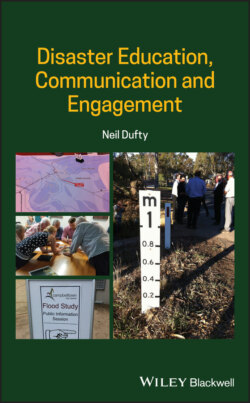Читать книгу Disaster Education, Communication and Engagement - Neil Dufty - Страница 8
2 Disaster ECE 2.1 Disaster Education 2.1.1 Defining Disaster Education
ОглавлениеDisaster education is becoming increasingly popular as a means of ensuring public safety, knowing that governments and infrastructure cannot protect all individuals and their communities in all emergencies. People need to look after themselves and others during and after disasters, and thus need to be educated in how to do this.
There is a strong involvement by emergency agencies around the world in disaster education. However, most agencies only commit relatively small proportions of their budgets to it, especially compared to those for emergency operations.
Ironically, although there are a multitude of avenues for education implementation related to disasters, there is according to Preston (2012) ‘surprisingly little writing in the field of education/pedagogy itself’. This is largely due to disaster education being a ‘new area of enquiry in the field of education’ (Preston 2012) and because many of the disaster education programmes are designed by non-educators from emergency agencies and other organisations. As a result, there is a large amount of disaster education activity around the world with little technical research into its educational veracity.
Furthermore, with technological developments such as social media, all people have the opportunity to be involved in disaster education. There is therefore a pressing need to examine disaster education in this context and provide robust education-based guidance to people using these emerging technologies for disaster education.
Preston (2012) notes that ‘the disciplinary boundaries of disaster education are fluid and the literature on the topic can be found within the sociology of disasters, public health and health promotion, humanitarian response, political communication and public relations’. Although more specific education-based research is required, it is useful that disaster education continues to draw upon and combine with other disciplines including education, psychology, and sociology in understanding people's reactions to disasters (see Chapter 5).
There are several definitions of disaster education that may lead to confusion about its place in disaster management. For example, Shaw et al. (2011) believe that ‘disaster education’, ‘disaster risk education’, and ‘disaster prevention education’ are ‘different expressions that essentially mean disaster risk reduction education’. Preston (2012) views disaster education more along the lines of preparedness: helping citizens ‘prepare for various disasters, consider what they would do in a disaster and think about how they would respond’.
An understanding of the meaning of the word ‘education’ will assist in resolving this confusion. Craft (1984) noted that there are two different Latin roots of the English word ‘education’. They are educare, which means to train or to mould, and educere, meaning to lead out. While the two meanings are quite different, they are both represented in the word ‘education’. They relate to different types of learning possible across education: one calls for rote memorisation and appropriate response; the other requires questioning, thinking, and creating.
Acknowledging this explanation and the Disaster Management Cycle (Chapter 3), disaster education should ‘involve learning before, during, and after disasters’ (Dufty 2011). The design of disaster education involves two components which will be discussed in detail later in this book:
1 Content – what will be learnt (see Chapter 8).
2 Methods – how it will be learnt (see Chapter 9).
